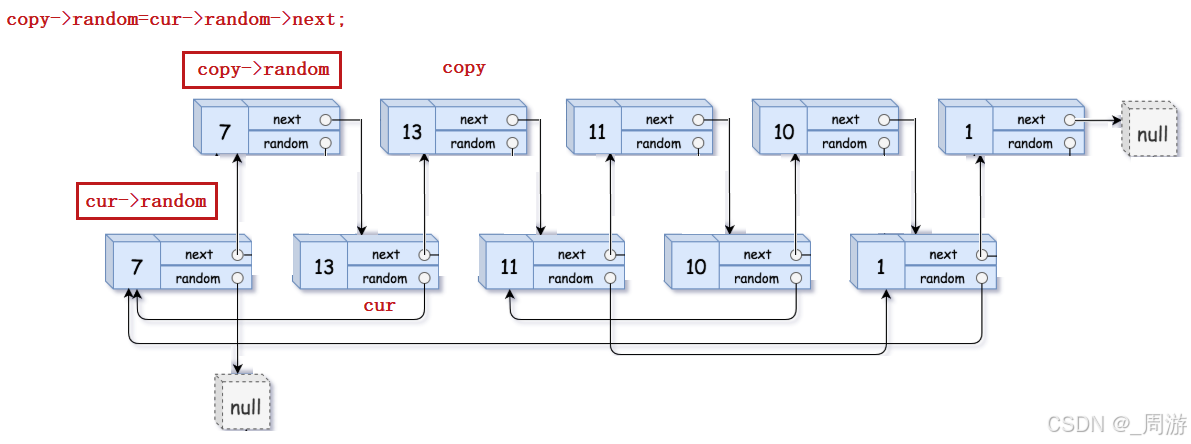题目描述
A国与B国是相邻的两个国家,每个国家都有很多城市。国家内部有很多连接城市的公路,国家之间也有很多跨国公路,连接两个国家的边界城市。两个国家一共有N个城市,编号从1到N,一共有M条公路,包括国内公路与跨国公路。小明生活在A国的城市1(即编号为1的城市),想去B国的城市N游玩,由于小明办理的是只能入境一次的签证,所以从城市1到城市N的路径中,只能通过一条跨国公路。每条公路都有一个距离,并且通过这条公路会有一个花费。请帮小明计算出从城市1到城市N的最短距离,在距离最短的前提下,再计算出最少花费。如果无法到达城市N,输出-1。
输入描述
- 第一行是一个整数N,表示两个国家的城市数量
- 第二行是一个整数M,表示两个国家的公路数量,包括国内公路与跨国公路
- 第三行是一个长度为N的字符串,字符串第i个(从1开始计数)字符为A或B,表示城市i属于A国或B国,其中第1个字符一定为A,第N个字符一定为B
- 接下来M行,每行包含4个整数U, V, W, C,表示编号为U的城市与编号为V的城市之间存在一条公路,长度是W,花费是C。每条公路是双向的。
输出描述
- 输出城市1到城市N的最短距离,并在距离最短的前提下,再输出最少花费。如果无法到达城市N,输出-1。
用例输入
5 5
AABBB
3 1 200 1
2 3 150 3
5 2 160 5
4 3 170 7
4 5 170 9
540 17
可以找到一条最优线路:城市1(A国) → 城市3(B国) → 城市4(B国) → 城市5(B国)。而且只通过一条跨国公路:城市1 → 城市3。
- 距离 = 200 + 170 + 170 = 540
- 花费 = 1 + 7 + 9 = 17
解题思路
我们可以使用 BFS (广度优先搜索)来解决这个问题。BFS 是处理最短路径问题的有效方法,但因为该问题同时涉及到 最短距离 和 最小花费,并且约束条件是最多只能使用一次跨国公路,因此我们需要对状态进行细致管理。
我们定义一个 状态结构体 (State) 来表示每个城市的状态,包括当前城市编号、当前总距离、当前总花费以及是否已经过跨国公路。为了保证同时考虑距离和花费,我们将每个城市分为两种状态:
flag = 0表示还没有经过跨国公路。flag = 1表示已经经过一次跨国公路。
使用 队列 (queue) 来模拟 BFS,对于每条公路(国内或跨国),根据是否是跨国公路的条件进行更新:
- 对于 国内公路,可以继续前进。
- 对于 跨国公路,只能走一次,且必须确保不重复跨国。
最终,通过 BFS 搜索完成后,输出到达城市N的最短距离和最小花费。
优化点:使用优先队列
代码
#include <iostream>
#include <vector>
#include <queue>
#include <climits>
using namespace std;
struct Edge {
int u, v, w, c;
};
struct State {
int dist, cost, node, flag;
bool operator>(const State& other) const {
// 优先按距离排,再按花费排
if (dist == other.dist) {
return cost > other.cost;
}
return dist > other.dist;
}
};
int main() {
int n, m;
cin >> n >> m;
string countries;
cin >> countries;
vector<vector<Edge>> graph(n + 1); // 图的邻接表
// 读取公路信息
for (int i = 0; i < m; i++) {
int u, v, w, c;
cin >> u >> v >> w >> c;
graph[u].push_back({ u, v, w, c });
graph[v].push_back({ v, u, w, c });
}
// 初始化距离和花费
vector<int> dist(n + 1, INT_MAX);
vector<int> cost(n + 1, INT_MAX);
dist[1] = 0;
cost[1] = 0;
priority_queue<State, vector<State>, greater<State>> pq;
pq.push({ 0, 0, 1, 0 }); // 从城市1开始,距离0,花费0,未跨国
while (!pq.empty()) {
State current = pq.top();
pq.pop();
int u = current.node;
int current_dist = current.dist;
int current_cost = current.cost;
int current_flag = current.flag;
if (current_dist > dist[u] || (current_dist == dist[u] && current_cost > cost[u])) {
continue; // 如果当前状态不是最优的,跳过
}
for (const Edge& edge : graph[u]) {
int v = edge.v;
int next_dist = current_dist + edge.w;
int next_cost = current_cost + edge.c;
bool isSameCountry = (countries[u - 1] == countries[v - 1]);
if (isSameCountry) {
// 国内公路,继续走
if (next_dist < dist[v] || (next_dist == dist[v] && next_cost < cost[v])) {
dist[v] = next_dist;
cost[v] = next_cost;
pq.push({ next_dist, next_cost, v, current_flag });
}
}
else {
// 跨国公路,只能走一次
if (current_flag == 0) {
if (next_dist < dist[v] || (next_dist == dist[v] && next_cost < cost[v])) {
dist[v] = next_dist;
cost[v] = next_cost;
pq.push({ next_dist, next_cost, v, 1 });
}
}
}
}
}
// 输出结果
if (dist[n] == INT_MAX) {
cout << -1 << endl; // 如果无法到达城市N
}
else {
cout << dist[n] << " " << cost[n] << endl; // 输出最短距离和最小花费
}
return 0;
}






![98,【6】 buuctf web [ISITDTU 2019]EasyPHP](https://i-blog.csdnimg.cn/direct/bf12ee475bb04b128de04bbdce64139b.png)











